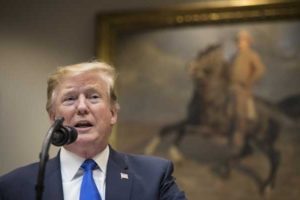The Trump administration is close to a trade deal with China that would roll back tariffs on both sides of the Pacific but may do little to achieve the substantive changes to China’s economy that the United States initially set out to win, people with knowledge of the talks said.
Significant details remain unsettled and the deal is still being discussed but so far, the two sides have agreed on a pact that would largely require Beijing to make big purchases of US agricultural and energy goods and to lower some barriers that prevent US companies from operating in China. In return, the United States would most likely drop its tariffs on at least $200 billion of the $250 billion worth of Chinese imports currently subject to US levies.
China, which has retaliated against President Donald Trump’s tariffs with its own punishing taxes on US goods, is pushing for the elimination of all of the Trump tariffs, a person with knowledge of the negotiations said. It is unclear whether the Trump administration will agree to remove all the tariffs or keep some in place to keep pressure on China. As part of the agreement, the Trump administration has been pushing China to accept an enforcement mechanism that would enable the United States to quickly reinstate tariffs if Beijing fails to live up to specific promises.
For Trump, the ability to announce a deal with China would constitute a victory for a presidency rocked by legal investigations and failed nuclear disarmament talks in North Korea last week. Trump has spent more than a year accusing China of unfair trade practices and promising to shift the balance of economic power back to the United States.
The agreement under discussion would expand markets for US financial services firms and farmers, in part by requiring that China buy large amounts of energy and farm goods, like liquid natural gas and soybeans.
But early details indicate it would do little to substantively change the way China has long done business and would not force Beijing to curtail cybertheft or the subsidies that the administration complains create an uneven playing field for US companies.
The language aimed at China’s discrimination against foreign companies, like its anti-monopoly law or standard-setting processes, is probably too vague to be enforceable, while China’s promises on curtailing subsidies are also overly broad, a person familiar with the negotiation said. The pact also doesn’t alter China’s tight restrictions on data, the person said. In addition, many of the big purchases that Beijing is promising would occur over a number of years, which could give China further leverage during that period, critics say.
Regardless of what Trump’s negotiators agree upon, no deal will be final until the president signs onto the agreement. Since starting his trade war last year, Trump has vacillated between accusing China of destroying US jobs and bragging about his strong relationship with President Xi Jinping and his ability to reach a trade deal. Trump recently began dangling a signing event with Xi at Mar-a-Lago, the president’s resort, and that ceremony seems to be coming together for later this month. While Trump wanted a summit earlier in the month, the event could occur at the end of March, after Xi finishes a scheduled trip through Europe, according to people familiar with the discussions.
China very much wants to present the image that a deal is at hand as several thousand top officials of the Chinese Communist Party and hundreds of the country’s most prominent business leaders gathered in Beijing over the weekend for the annual session of the legislature, the National People’s Congress, which starts Tuesday.
The Chinese government has been willing to discuss moves that it perceives as being in China’s interest, from long-term purchases of commodities that are needed for Chinese factories to changes in China’s foreign investment law that make it a more attractive place for overseas companies to operate. But people familiar with the Chinese government’s stance say it is determined to say no to policy changes that do not benefit its interest.
Beijing has carried out most of the legal work needed for the legislature to pass a new, comprehensive law on investment by foreign businesses that would help satisfy some of America’s earlier demands. The law will be the framework for China to reduce its limits on foreign stakes in Chinese banks, insurers and asset management companies — something that Xi had agreed to do in November 2017, when Trump came to Beijing for talks before the trade war.
In a congressional hearing last week, Robert Lighthizer, the US trade representative, signalled a long road ahead to reaching an agreement but said the United States would push for a substantive deal that did not merely result in purchases of US goods.
“What we want is fair trade that requires structural change and it has to be enforceable,” Lighthizer said.
He said the United States and China were working to establish an enforcement mechanism that would involve an extensive series of meetings at various levels of government and the threat of tariffs if China was found to have violated the trade agreement.
The Chinese continue to be concerned that, after they have made concessions to get to the brink of a deal, Trump will be convinced by more hawkish voices in the media or the administration to try to press China for even more, said Eswar Prasad, a senior fellow at the Brookings Institution.
The trade deal under discussion stems from the Trump administration’s findings last March that Beijing was engaging in unfair trade practices, including pressuring or requiring US companies to transfer their technology and intellectual property to Chinese partners as a condition of doing business in the country. The investigation found that China’s practices hurt US exports, job numbers and wages.
Trump has long attacked China’s economic practices, likening it to a “rape of our country” and “the greatest theft in the history of the world” while campaigning for the White House.
The president has continued to accuse China of engaging in nefarious practices to get a leg up in global trade and has imposed tariffs on $250 billion worth of Chinese goods to pressure Beijing to stop. The trade war, which has raged for months, has begun to hurt US companies that depend on China for sales and production, and many large multinational firms have said the trade war will crimp 2019 profits.
David Loevinger, who was the Treasury’s senior coordinator for China affairs in the first term of the Obama administration, said he thought there was too much optimism in China and the United States that a trade deal would roll back most or all of the tariffs that Trump imposed last year.
“What’s very clear is we’ve reached the peak of the tariff war,” said Loevinger, now a managing director for emerging markets at TCW, an asset-management company in Los Angeles. “The question is how much of a rollback do we get — my expectation is probably not very much.”
Last week, Trump said he would delay imposing higher tariffs on $200 billion worth of Chinese goods, citing substantial progress in trade talks. On Saturday, Trump said he was asking China to end its retaliatory tariffs on meat and other products.
“I have asked China to immediately remove all Tariffs on our agricultural products (including beef, pork, etc.) based on the fact that we are moving along nicely with Trade discussions and I did not increase their second tranche of Tariffs to 25% on March 1st,” the president tweeted Saturday. “This is very important for our great farmers — and me!”





















